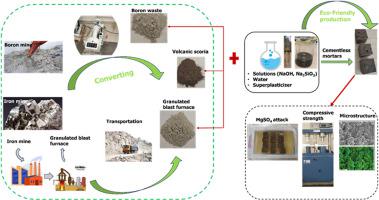当前位置:
X-MOL 学术
›
J. Build. Eng.
›
论文详情
Our official English website, www.x-mol.net, welcomes your
feedback! (Note: you will need to create a separate account there.)
Resistance to magnesium sulphate attack of binary and ternary cementless self-compacting alkali-activated mortar
Journal of Building Engineering ( IF 6.7 ) Pub Date : 2024-07-01 , DOI: 10.1016/j.jobe.2024.109988 Merve Şahin Yön , Mehmet Karataş
Journal of Building Engineering ( IF 6.7 ) Pub Date : 2024-07-01 , DOI: 10.1016/j.jobe.2024.109988 Merve Şahin Yön , Mehmet Karataş

|
The aim of this study is to investigate the effect of sulphate on self-compacting alkali-activated mortars (SCAAMs) produced using volcanic scoria (V), boron waste (B) and granulated blast furnace slag (G) together with alkali activators. Thus, the production of cement-free alkali-active mortar by recycling waste and reducing the CO effect increases the importance of this study. The fact that the waste material is provided free of charge and that V is readily available from nature provides economic advantages in the production of these mortars. In this experimental study, magnesium sulphate solution was utilized to define the sulphate resistance of SCAAMs. In binary SCAAMs, B was used with G in a ratio of NS:NH = 3.0, with an increase from 5 % to 15 %; in ternary mixtures, B was used together with G and V in the same proportions, in a ratio of NS:NH = 1.0. The tests involved immersion in 5 % magnesium sulphate solution for 1, 3 and 6 months. Mass development, compressive strength, visual inspection and microstructural changes were investigated. In general, the binary SCAAMs performed better in magnesium sulphate solution than the ternary SCAAMs, except in the 6th month. Considering the samples with the highest B content, a 100 % loss of compressive strength occurred in the B15G85 sample under the influence of sulphate for 6 months, while a loss of compressive strength of about 15 % occurred in the B15G40V45 sample. The results showed that the increase in B content caused a severe deterioration of the sulphate effect in the samples over time and that the V additive had a positive effect on the sulphate resistance.
中文翻译:

二元、三元无水泥自密实碱激活砂浆的抗硫酸镁侵蚀性能
本研究的目的是研究硫酸盐对使用火山渣 (V)、硼废料 (B) 和粒化高炉矿渣 (G) 以及碱活化剂生产的自密实碱活化砂浆 (SCAAM) 的影响。因此,通过回收废物和减少CO效应来生产无水泥碱活性砂浆增加了这项研究的重要性。事实上,废料是免费提供的,而且 V 很容易从自然界中获得,这为这些砂浆的生产提供了经济优势。在本实验研究中,使用硫酸镁溶液来确定 SCAAM 的耐硫酸盐性。在二元SCAAM中,B与G的比例为NS:NH = 3.0,从5%增加到15%;在三元混合物中,B与G和V以相同的比例一起使用,其比例为NS:NH = 1.0。测试包括在 5% 硫酸镁溶液中浸泡 1、3 和 6 个月。研究了质量发展、抗压强度、目视检查和微观结构变化。一般来说,除第 6 个月外,二元 SCAAM 在硫酸镁溶液中的表现优于三元 SCAAM。考虑到B含量最高的样品,在硫酸盐的影响下6个月,B15G85样品的抗压强度发生了100%的损失,而B15G40V45样品的抗压强度损失了约15%。结果表明,随着时间的推移,B 含量的增加导致样品中的硫酸盐效果严重恶化,而 V 添加剂对抗硫酸盐性具有积极影响。
更新日期:2024-07-01
中文翻译:

二元、三元无水泥自密实碱激活砂浆的抗硫酸镁侵蚀性能
本研究的目的是研究硫酸盐对使用火山渣 (V)、硼废料 (B) 和粒化高炉矿渣 (G) 以及碱活化剂生产的自密实碱活化砂浆 (SCAAM) 的影响。因此,通过回收废物和减少CO效应来生产无水泥碱活性砂浆增加了这项研究的重要性。事实上,废料是免费提供的,而且 V 很容易从自然界中获得,这为这些砂浆的生产提供了经济优势。在本实验研究中,使用硫酸镁溶液来确定 SCAAM 的耐硫酸盐性。在二元SCAAM中,B与G的比例为NS:NH = 3.0,从5%增加到15%;在三元混合物中,B与G和V以相同的比例一起使用,其比例为NS:NH = 1.0。测试包括在 5% 硫酸镁溶液中浸泡 1、3 和 6 个月。研究了质量发展、抗压强度、目视检查和微观结构变化。一般来说,除第 6 个月外,二元 SCAAM 在硫酸镁溶液中的表现优于三元 SCAAM。考虑到B含量最高的样品,在硫酸盐的影响下6个月,B15G85样品的抗压强度发生了100%的损失,而B15G40V45样品的抗压强度损失了约15%。结果表明,随着时间的推移,B 含量的增加导致样品中的硫酸盐效果严重恶化,而 V 添加剂对抗硫酸盐性具有积极影响。











































 京公网安备 11010802027423号
京公网安备 11010802027423号